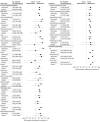COVID-19 Vaccine Booster Uptake and Effectiveness Among US Adults With Cancer
- PMID: 40674059
- PMCID: PMC12272354
- DOI: 10.1001/jamaoncol.2025.2020
COVID-19 Vaccine Booster Uptake and Effectiveness Among US Adults With Cancer
Abstract
Importance: Persons with cancer are at increased risk of severe COVID-19 infection, but the additional benefit of COVID-19 boosters is unclear.
Objective: To assess COVID-19 vaccine effectiveness (VE) and number needed to vaccinate (NNV) among persons with cancer of an additional dose of the monovalent COVID-19 vaccine.
Design, setting, and participants: Retrospective cohort study conducted in 4 health care systems in the US among persons with cancer receiving chemotherapy or immunotherapy. Statistical analysis was conducted between March 2023 and August 2024.
Exposures: Receipt of an additional dose of the monovalent COVID-19 vaccine before January 1, 2022, with follow-up until August 31, 2022, and the bivalent COVID-19 vaccine from September 1, 2022, to August 31, 2023.
Main outcomes and measures: COVID-19 hospitalization, diagnosed COVID-19, and COVID-19-related intensive care unit (ICU) admission.
Results: Among 72 831 persons with cancer (17 922 female individuals [24.6%]), 69% received a monovalent booster by January 1, 2022. During 34 006 person-years of follow-up, the COVID-19 hospitalization rate was 30.5 per 1000 person-years among patients who received a monovalent booster vs 41.9 per 1000 person-years among patients who received the primary series alone, with an adjusted VE of 29.2% (95% CI, 19.9%-37.3%) and NNV to prevent 1 COVID-19 hospitalization of 166 (95% CI, 130-244). There was also significant VE to prevent diagnosed COVID-19 (8.5% [95% CI, 3.7%-13.0%]) and COVID-19-related ICU admission (35.6% [95% CI, 20.0%-48.3%]). Among 88 417 persons with cancer (24 589 female individuals [27.8%]) with 81 027 person-years of follow-up during the bivalent period, patients who received this booster (38%) had a COVID-19 hospitalization rate of 13.4 per 1000 person-years vs 21.7 per 1000 person-years among persons who did not receive a bivalent vaccine, with an adjusted VE of 29.9% (95% CI, 19.4%-39.1%) and NNV to prevent 1 COVID-19 hospitalization of 451 (95% CI, 345-697); the adjusted VE was 30.1% (95% CI, 7.7%-47.0%) to prevent COVID-19-related ICU admission.
Conclusions and relevance: In this retrospective cohort study, COVID-19 booster vaccinations were associated with significant protection against severe COVID-19, with a favorable NNV among persons with cancer. However, uptake of COVID-19 vaccine boosters was low, and interventions are therefore justified to increase COVID-19 uptake in this high-risk population.
Conflict of interest statement
Figures

Comment on
-
Considerations for Using Clinical Practice Data to Study COVID-19 Vaccines in Patients With Cancer.JAMA Oncol. 2025 Sep 1;11(9):965-967. doi: 10.1001/jamaoncol.2025.1937. JAMA Oncol. 2025. PMID: 40674086 No abstract available.
References
-
- Dai M, Liu D, Liu M, et al. Patients with cancer appear more vulnerable to SARS-CoV-2: a multicenter study during the COVID-19 outbreak. Cancer Discov. 2020;10(6):783-791. doi: 10.1158/2159-8290.CD-20-0422 - DOI - PMC - PubMed
-
- US Centers for Disease Control and Prevention . Interim clinical considerations for use of COVID-19 vaccines in the United States. May 12, 2025. Accessed June 4, 2025. https://www.cdc.gov/vaccines/covid-19/clinical-considerations/interim-co...
Publication types
MeSH terms
Substances
Grants and funding
LinkOut - more resources
Full Text Sources
Medical

